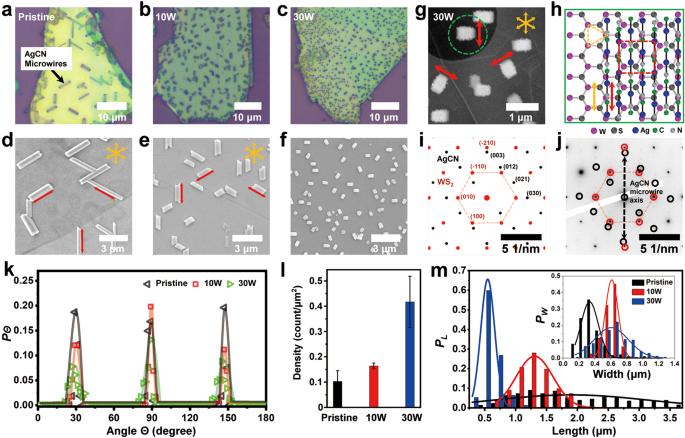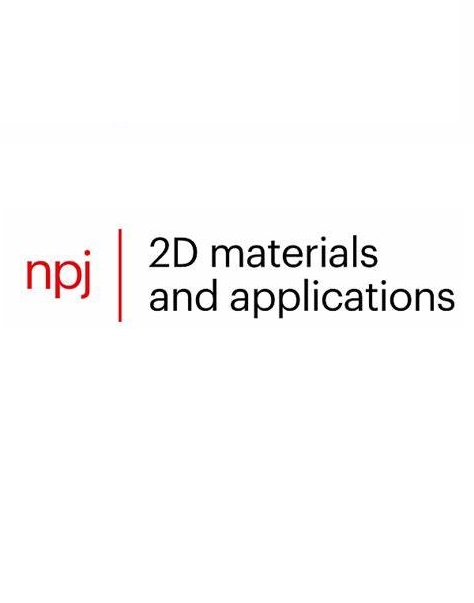Controlled epitaxy and patterned growth of one-dimensional crystals via surface treatment of two-dimensional templates
IF 8.8
2区 材料科学
Q1 MATERIALS SCIENCE, MULTIDISCIPLINARY
引用次数: 0
Abstract
Mixed-dimensional van der Waals (vdW) heterostructures offer promising platforms for exploring interesting phenomena and functionalities. To exploit their full potential, precise epitaxial processes and well-defined heterointerfaces between different components are essential. Here, we control the growth of one-dimensional (1D) vdW microwires on hexagonal crystals via plasma treatment of the growth templates. AgCN serves as a model 1D system for examining the dependence of the nucleation and growth parameters on the surface treatment conditions and substrate types. The oxygen-plasma-treated transition metal dichalcogenides form step edges mediated by formation of surface metal oxides, leading to robust AgCN epitaxy with an enhanced nucleation density and low horizontal growth rates. Monte Carlo simulations reproduce the experimentally observed growth behaviors and unveil the crucial growth parameters, such as surface diffusivity. The plasma treatment results in distinct effects on graphite and hexagonal boron nitride templates, which undergo plasma-induced amorphization and deactivation of the AgCN vdW epitaxy. We achieve the selective growth of AgCN microwires on graphite using the deactivated vdW epitaxy. This study offers significant insights into the impact of surface treatment on 1D vdW epitaxy, opening avenues for controlled fabrication of mixed-dimensional vdW heterostructures.

通过二维模板的表面处理实现一维晶体的可控外延和图案化生长
混合维范德华(vdW)异质结构为探索有趣的现象和功能提供了前景广阔的平台。要充分挖掘其潜力,精确的外延工艺和不同成分之间定义明确的异质界面至关重要。在这里,我们通过对生长模板进行等离子体处理,控制一维(1D)vdW 微线在六方晶体上的生长。以 AgCN 为一维模型系统,研究成核和生长参数与表面处理条件和基底类型的关系。经氧等离子体处理的过渡金属二钙化物在表面金属氧化物的介导下形成阶梯边,导致 AgCN 外延生长强劲,成核密度提高,水平生长率降低。蒙特卡罗模拟再现了实验观察到的生长行为,并揭示了关键的生长参数,如表面扩散率。等离子体处理对石墨和六方氮化硼模板产生了不同的影响,石墨和六方氮化硼模板在等离子体的诱导下发生非晶化,并使 AgCN vdW 外延失活。我们利用失活 vdW 外延技术在石墨上实现了 AgCN 微线的选择性生长。这项研究深入揭示了表面处理对一维 vdW 外延的影响,为控制制造混合维 vdW 异质结构开辟了道路。
本文章由计算机程序翻译,如有差异,请以英文原文为准。
求助全文
约1分钟内获得全文
求助全文
来源期刊

npj 2D Materials and Applications
Engineering-Mechanics of Materials
CiteScore
14.50
自引率
2.10%
发文量
80
审稿时长
15 weeks
期刊介绍:
npj 2D Materials and Applications publishes papers on the fundamental behavior, synthesis, properties and applications of existing and emerging 2D materials. By selecting papers with the potential for impact, the journal aims to facilitate the transfer of the research of 2D materials into wide-ranging applications.
 求助内容:
求助内容: 应助结果提醒方式:
应助结果提醒方式:


